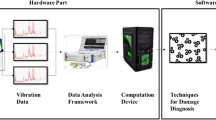Abstract
The structural damage identification, which entails finding a best approximate solution to an over-determined system of linear equations, is actually one of the practical problems encountered in structural health monitoring. A major challenge to structural damage identification is the ill-conditioned problem caused by noise contamination and spatially incomplete measurements. A novel Tikhonov regularization iterative method (TRIM) is proposed to solve the ill-conditioned system of linear equations. This method iteratively reconstructs the regularization matrix by gradually updating the regularized solution. A merit is that the false-positive indicators of damage are greatly reduced; and as a result this approach would be able to detect smaller damages that could not be detected by using traditional approaches. Another development embedded in TRIM is that a procedure, called singular value dichotomy, is developed to determine the regularization parameters. Several problems, such as the tremendous prior trials, due to the application of L-curve, are avoided. A numerical study is conducted on an offshore platform structure to demonstrate the effectiveness of the proposed method. The result shows that the new method outperforms the traditional Tikhonov regularization method in damage identification.




















Similar content being viewed by others
References
Mojtahedi A, Yaghin M, Hassanzadeh Y et al (2011) Developing a robust SHM method for offshore jacket platform using model updating and fuzzy logic system. Appl Ocean Res 33:398–411
Doebling S, Farrar C, Prime M (1998) A summary review of vibration-based damage identification methods. Shock Vib Dig 30:91–105
Li YY (2010) Hypersensitivity of strain-based indicators for structural damage identification: a review. Mech Syst Signal Pr 24:653–664
Fan W, Qiao PZ (2011) Vibration-based damage identification methods: a review and comparative study. Struct Health Monit 10:83–111
Shi ZY, Law SS, Zhang LM (2000) Structural damage identification from modal strain energy change. J Eng Mech 126:1216–1223
Hu SLJ, Li HJ, Wang SQ (2006) Cross-modal strain energy method for estimating damage severity. J Eng Mech 132(4):429–437
Li HJ, Fang H, Hu SLJ (2007) Damage localization and severity estimate for three-dimensional frame structures. J Sound Vib 301:481–494
Wang SQ, Li HJ, Hu SLJ (2007) Cross modal strain energy method for damage localization and severity estimation. In: International conference on offshore mechanics and arctic engineering. San Diego, California, USA, pp 245–249
Xu MQ, Wang SQ (2017) Cross modal strain energy-based structural damage identification in the presence of noise effects. Adv Mech Eng 9:1–14
Faddeev DK, Faddeeva VN (1962) On ill-conditioned systems of linear equations. Ussr Comput Math Math Phys 1(3):447–454
Stutz LT, Tenenbaum RA, Corrêa RAP (2015) The differential evolution method applied to continuum damage identification via flexibility matrix. J Sound Vib 345:86–102
Entezami A, Shariatmadar H, Sarmadi H (2017) Structural damage identification by a new iterative regularization method and an improved sensitivity function. J Sound Vib 399:285–307
Riley JD (1955) Solving systems of linear equations with a positive definite, symmetric, but possibly ill-conditioned matrix. Math Tables Other Aids Comput 9(51):96–101
Golub GH, Hansen PC, O’Leary DP (1999) Tikhonov regularization and total least squares. Siam J Matrix Anal Appl 21:185–194
Engl HW, Ramlau R (2000) Regularization of inverse problems. Kluwer Academic, Norwell, pp 347–366
Hansen PC (2007) Regularization tools version 4.0 for Matlab 7.3. Numer Algorithms 4:189–194
Calvetti D, Reichel L (2003) Tikhonov regularization of large linear problems. Bit Numer Math 43:263–283
Weber B, Paultre P, Proulx J (2009) Consistent regularization of nonlinear model updating for damage identification. Mech Syst Signal Pr 23:1965–1985
Zhang C, Song GQ, Wu GY (2012) Structure damage identification by finite element model updated with improved Tikhonov regularization. Eng Mech 29:29–30
Tian FZ, Hong ZJ, Zhang C et al (2016) The application of model updating with L1/2-in structural damage identification. J Nanchang Univ (Natural Science) 40:131–136
Guyan RJ (1965) Reduction of stiffness and mass matrices. AIAA J 3:380–380
Hansen PC, O’Leary DP (1993) The use of the L-curve in the regularization of discrete ill-posed problems. Siam J Sci Comput 14:1487–1503
Wang SQ (2013) Damage identification in offshore platform structures from limited modal data. Appl Ocean Res 41:48–56
Mottershead JE, Friswell MI (1993) Model updating in structural dynamics: a survey. J Sound Vib 167:347–375
Messina A, Williams EJ, Contursi T (1998) Structural damage detection by a sensitivity and statistical-based method. J Sound Vib 216(5):791–808
Wang SQ, Liu FS (2010) New accuracy indicator to quantify the true and false modes for eigensystem realization algorithm. Struct Eng Mech 34:625–634
Acknowledgements
The authors acknowledge the support by the National Science Fund for Distinguished Young Scholars (51625902), the National Natural Science Foundation of China (51379196), and the Taishan Scholars Program of Shandong Province (TS201511016). And the valuable comments from three anonymous reviewers are highly appreciated.
Author information
Authors and Affiliations
Corresponding author
Ethics declarations
Conflict of interest
The authors declare that there is no conflict of interest.
About this article
Cite this article
Wang, S., Xu, M., Xia, Z. et al. A novel Tikhonov regularization-based iterative method for structural damage identification of offshore platforms. J Mar Sci Technol 24, 575–592 (2019). https://doi.org/10.1007/s00773-018-0579-6
Received:
Accepted:
Published:
Issue Date:
DOI: https://doi.org/10.1007/s00773-018-0579-6




